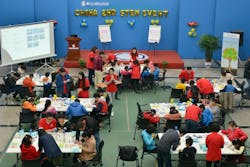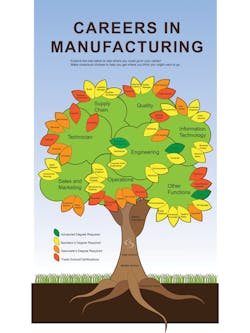Engineering Jobs Are in Demand, But Who Will Fill Them?
Emerging technologies like Artificial Intelligence (AI), automation, Machine Learning, and Big Data are revolutionizing the way people work—and virtually every industry is being touched. Not surprisingly, then, companies around the world are heavily investing in these technologies, not only to power business growth today but also in the hopes of finding innovative applications that will be drivers of value in the future. This year alone, investment in AI and related technologies is expected to reach $19.1 billion, and the pace of that investment is only expected to increase going forward.
These five girls (pictured with Benedict Cumberbach) were the finalists at last year’s Doctor Strange STEM Challenge.
And yet, if this flurry of spending is to generate value, it ultimately depends upon the day-to-day work of engineers. Today, engineers across a host of different fields—from robotics and machine learning to more traditional disciplines such as electric and mechanical engineering—are literally building the business applications of the future.
But with so much demand, employers are having an increasingly difficult time recruiting and hiring the talent they need to fill critical roles. Where is the lack of available engineering talent being felt most acutely, and what can companies do to better prepare existing employees for the business needs of tomorrow?
Hot Jobs in Engineering
Engineering opportunities across the board are expected to grow seven percent nationwide by 2026, according to the U.S. Bureau of Labor Statistics (BLS). But demand for some roles is increasing faster than for others. Here are the five hottest engineering jobs currently on the market.
Robotics engineers. Make way for robots…and the people who build them. In 2016 IFR.org published that the number of industrial robots deployed worldwide is expected to increase to around 2.6 million units by 2019, with demand especially concentrated in the manufacturing sector. Looking ahead, the deployment of increasingly compact, easy-to-use, collaborative robots will likely find a host of exciting new business applications in the coming years, so look for robotics engineers to continue to be highly in demand.
Machine Learning engineers. Machine Learning engineers create programs that enable machines to perform essential business functions. They’re also expected to be able to think holistically and carry out rigorous A/B testing. And though the discipline originates in software data engineering, it has expanded in recent years, becoming more specialized in response to ongoing technological evolution. Since Machine Learning engineers are so closely tied to business impact, it should come as no surprise that demand for these professionals is expected to increase 11% by 2024, according to the BLS.
Electrical and electronics engineers. Opportunities for electrical and electronics engineers are expected to increase going forward, leading to the creation of 21,000 new jobs by 2026, according to the BLS. As demand for sophisticated electrical, electronic devices, and products continues to grow, so too will the demand for these professionals. Particularly because of the potential business impact of emerging technologies, companies are eager to find candidates with the skills to harness them to drive bottom-line value.
Controls engineers. These engineers establish operations-critical systems and mechanisms, governing everything from software development and coding to conceptual system design. With greater automation, controls engineers will be needed to develop still more complex systems and mechanisms. So look for controls engineers to remain among the most sought-after candidates at innovative companies in the future.
Embedded systems engineers. Demand for greater connectivity—and for smarter, more power-efficient electronic technology—is leading to a shortage of qualified embedded systems engineers in the labor market. In addition to deep-seated technical capabilities, top candidates today should possess strong critical thinking, in addition to problem-solving and communication skills. (after all, teamwork is an essential part of the job description). And in an increasingly interconnected world, companies are also eager to find candidates who combine core coding expertise with an expert understanding of how software and hardware systems communicate.
While new opportunities in engineering—and entirely new roles—will emerge as a consequence of new technology and ongoing innovation, employers will likely find that many of these openings are difficult to fill. In part, that’s because of an aging workforce: In the U.S. right now, 10,000 baby boomers turn 65 every single day, and the 65-and-over population will nearly double over the next three decades. Another cause is the relative paucity of students pursuing engineering as a field of study, which is contributing to the engineering skills gap in the talent market.
Further, the unemployment rate for engineers (2.3%) is even lower than the national average, which is itself the lowest it has been in 50 years. At the same time, according to a report from the Institution of Engineering and Technology (IET), many employers today feel that most undergraduate engineering curricula don’t adequately prepare students to take on the real-world challenges of engineering roles when they graduate.
STEM issues are global. Cooper Standard is expanding its STEM initiatives to different countries including China, Mexico, and Jamaica.
These factors and more are creating an imbalance between the number of openings in engineering and the number of qualified candidates who are available to fill them. And when companies can’t find the engineering talent they need, that hurts their bottom lines.
Upskill Your Employees
Upskilling is a strategic, proactive way of addressing engineering-related talent shortages. It enables companies to maximize the value of their existing workforces, without requiring the level of investment—in terms of time and resources—associated with hiring and training a new hire. Plus, upskilling can have a number of ancillary benefits.
For instance, it could help keep employees more engaged, and that, in turn, can have an impact on retention. After all, one study found that 86% of millennials would be willing to stay in their current roles if they had access to career training and development opportunities. Unfortunately, right now nearly 40% of U.S. employees say their employers have not offered or paid for upskilling opportunities. But that’s likely going to change in the future: The demand for engineers isn’t about to abate, and employers will be forced to consider new approaches to address all of their talent needs.
STEM Pipeline
Today, there are a number of top-down initiatives in place to encourage students to pursue STEM-related careers, but the full impact of these initiatives isn’t likely going to be felt for some time. In the interim, organizational leaders should consider partnering with schools to nurture interest in STEM careers, or else creating programs that incentivize and reward students who pursue STEM careers with scholarship money. Employees can get involved, too—it’s a great opportunity for employees to teach and learn at the same time.
Women in STEM
Women comprise only 13% of the engineering workforce today—and that needs to change, fast. One way companies can help drive that change is by encouraging female leaders and providing all employees with mentors. You might also consider partnering with an organization or working group that supports female leadership. That’s particularly important, because right now women in tech jobs in the U.S. tend to leave the field at a 45% higher rate than men. So companies need to get proactive. And that means not just talking about the barriers in the engineering sector as it relates to women, but taking meaningful actions to break them.
Of course, these are only a few of the ways that companies today are working to overcome the engineering skills gap. In the near future, it seems, finding the necessary engineering talent to deliver on business goals will continue to be a challenge for many organizations. But, by acting strategically today, companies can start to address this challenge—and ultimately attain a competitive advantage in the talent marketplace tomorrow.
Angie Keller is senior vice president at Randstad Engineering.
About the Author
Angie Keller
Senior VP
Angie Keller is the senior vice president at Randstad Engineering, which specializes in the sourcing and placement of temporary and direct hire professionals in engineering, energy, utilities, petrochemical, manufacturing, information technology, and more. Keller oversees sales and recruiting teams within Randstad Engineering. Randstad US manages a workforce of more than 100,000 people for thousands of clients each week.




